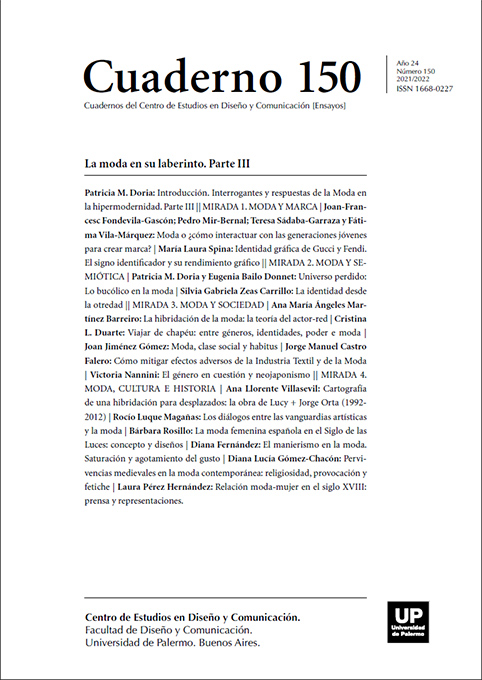Pervivencias medievales en la moda contemporánea: religiosidad, provocación y fetiche
Abstract
A detailed analysis of the contemporary fashion collections of some of the leading firms and designers reveals the links between two seemingly distant worlds such as the Middle Ages and the contemporary catwalk and visual culture. The comparative study between medieval religiosity and its expression from a profane approach in fashion, in haute couture, as well as in prêt-à-porter or ready-to-wear, will allow us to approach the use of gemmed crosses, reliquaries, Sacred Hearts , Arma Christi, etc., both in garments and in a wide selection of accessories. Added to this is the construction of the image of women as an object of worship-desire. A concept that, once again, has its roots in the medieval world, and in which we are presented with the personification of Nature as the embodiment of feminine essence and sexuality.
References
Bolton, A. (2011). Alexander McQueen. Savage Beauty. Nueva York: The Metropolitan Museum of Art.
Bolton, A. (ed.). (2018). Heavenly Bodies. Fashion and the Catholic Imagination. Nueva York: The Metropolitan Museum of Art, 2 vols.
Borrelli-Persson, L. (2000). Christian Dior. Fall 2000 Couture. Vogue, 8 de julio de 2000. Recuperado de: https://www.vogue.com/fashion-shows/fall-2000-couture/christian-dior
Donzé, P-Y y Wubs, B. (2019). Storytelling and the making of global luxury fashion brand: Christian Dior. International Journal of Fashion Studies, 6 (1), 83-102.
Gleason, K. (2012). Alexander McQueen. Evolution. Nueva York: Race Point Publishing.
Guillaume de Lorris y Jean de Meun (2020). El Libro de la Rosa, ed. de Carlos Alvar y Julián Muela. Madrid: Alianza editorial.
Horyn, C. (2000). Review/Fashion; Life as a Party, With a Fetishistic Back Room. The New York Times, 11 de julio de 2000. Recuperado de: https://www.nytimes.com/2000/07/11/style/review-fashion-life-as-a-party-with-a-fetishistic-back-room.html
Lores, A. (2020). Judy Chicago, la artista feminista detrás del último desfile de Dior alta costura. Vanity Fair, 20 de enero de 2020. Recuperado de: https://www.revistavanityfair.es/lujo/moda/articulos/judy-chicago-artista-feminista-desfile-dior-alta-costura/42913
Menkes, S. (2016): Christopher Kane: coser y remendar. Vogue, 19 de septiembre de 2016. Recuperado de: https://www.vogue.es/suzy-menkes/articulos/suzy-menkes-london-primavera-verano-2017-christopher-kane/26835
Molina, Á. (2020). Dior y Hudy Chicago, el enésimo idilio entre arte y moda. El País, 25 de enero de 2020.
Mower, S. (2004). Alexander McQueen Fall 2004 Ready-to-Wear. Vogue, 4 de marzo de 2004. Recuperado de: https://www.vogue.com/fashion-shows/fall-2004-ready-to-wear/alexander-mcqueen
Mower, S. (2007). Jean Paul Gaultier 2007 Couture. Vogue, 23 de enero de 2007. Recuperado de: https://www.vogue.com/fashion-shows/spring-2007-couture/jean-paul-gaultier
Nagel, A. (2010). The Afterlife of the Reliquary. En: Bagnoli, M., Klein, H. A., Griffith Mann, C. y Robinson, J. (eds.). Treasures of Heaven. Saints, Relics, and Devotion in Medieval Europe (pp. 211-222). New Haven y Londres: Yale University Press.
Newman, B. (2002). God and the Goddesses. Vision, Poetry, and Belief in the Middle Ages. Philadelphia: University of Pennsylvania Press.
Pastoureau, M. (2017). Red. The History of a Color. Princeton y Oxford: Princeton University Press.
Puga, J. (2018). «Mis corazones no son marketing». Agatha Ruiz de la Prada. Diseñadora y premio ADYMO de Moda 2018. El Comercio, 28 de septiembre de 2018. Recuperado de: https://www.elcomercio.es/gente-estilo/agatha-ruiz-prada-corazones-marketing-20180928003436-ntvo.html
Rodríguez Peinado, L. (2010). La Crucifixión. Revista Digital de Iconografía Medieval II (4), 29-40. Recuperado de: https://www.ucm.es/data/cont/docs/621-2013-11-21-6.%20Crucifixi%C3%B3n.pdf
Rodríguez Peinado, L. (2014a). La Anunciación. Revista Digital de Iconografía Medieval, VI (12), 1-16. Recuperado de: https://www.ucm.es/data/cont/docs/621-2014-12-06-03.%20Anunciaci%C3%B3n.pdf
Rodríguez Peinado, L. (2014b). Púrpura. Materialidad y simbolismo en la Edad Media. Anales de Historia del Arte, 24, número especial noviembre, 471-495. Recuperado de: https://revistas.ucm.es/index.php/ANHA/article/view/48289/45189
Sant, G. Van (2010). Madonna. Interview, 3 de mayo de 2010. Recuperado de: https://www.interviewmagazine.com/music/madonna
Santiago de la Vorágine (2004). La leyenda dorada. Madrid: Alianza Forma, 2 vols.
Simons, P. (2019). The Flaming Heart: Pious and Amorous Passion in Early Modern European Medical and Visual Culture. En: Barclay, K. y Reddan, B. (eds.). The Feeling Heart in Medieval and Early Modern Europe: Meaning, Embodiment, and Making (pp. 19-42). Medieval Institute Publications.
Steele, V. (2018). Fashion Theory. Hacia una teoría cultural de la moda. Buenos Aires: Ampersand.
Walker Vadillo, M. (2013). Le Roman de la Rose. Revista Digital de Iconografía Medieval, V (10), 27-39. Recuperado de: https://www.ucm.es/data/cont/docs/621-2013-12-14-05.%20Roman%20de%20la%20rose.pdf
Yllera, A. (1979). El “Roman de la Rose” y los “Cuentos de Canterbury” de Chaucer: visión del mundo y concepción del hombre y de la sociedad. Cuadernos de investigación filológica, 5, 3-21.
Los autores/as que publiquen en esta revista ceden los derechos de autor y de publicación a "Cuadernos del Centro de Estudios de Diseño y Comunicación", Aceptando el registro de su trabajo bajo una licencia de atribución de Creative Commons, que permite a terceros utilizar lo publicado siempre que de el crédito pertinente a los autores y a esta revista.


